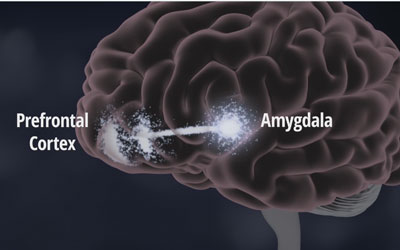New research builds upon our understanding of the Amygdala to Pre-Frontal Cortex connection. How can we more easily self-regulate?
Self-regulation is the foundation of stress control and optimal performance. Biofeedback proves to be a viable tool for training this key function built into the human brain’s ability to adapt and survive.
“If you know what pushes your buttons, you don’t have to be a victim of your amygdala”, Miro Cansky explains on his Mindfulness 4 All site.
“A research paper just came out, demonstrating that greater awareness of negative stimuli makes it easier for the amygdala-prefrontal cortex circuitry to be engaged, which means that the emotional reaction to the stimuli is not so intense.
You can read more here:Mindfulness 4 All, Miro Cansky.
Do you agree that those who cultivate awareness have a better ability to regulate their emotions?
But how does this actually work? How can I achieve awareness and better regulate my emotions?
The research shows both functional and structural neuroimaging evidence that a critical amygdala-prefrontal emotion-regulatory network selectively impacts behavior following awareness of negative cues.
In our words, if you feel anxious or angry without knowing why, the fight or flight response of your brain will be stronger and it’s effects last longer. However, if you know why — what thought, image or sound causes your frustration, the pre-frontal cortex, your cognitive top-level thinking brain, will communicate with your more emotional amygdala and calm you down.
This is true feedback in action: active-feedback, biofeedback in action.
Biofeedback tools help you feel and see anxieties which you might or might not know affect you. You can cultivate awareness of the present state effects which arise from past thoughts and underlying themes. This feedback awareness allows you to connect thoughts to anxieties or stresses, thereby, activating the pre-frontal cortex thinking brain to lessen the emotional amygdala’s effect.
The beauty in this? The sparkle, the sunlight in the depth of the research inside the brain scanner?
With a simple feedback technique, awareness is created almost effortlessly. With awareness you AUTOMATICALLY begin to take control without having to do anything else!
Seeing is believing, yes? (See Erik Peper’s article on Biofeedback led client epiphany.)
You can read the full research paper as published in nature.com here: Awareness of Emotional Stimuli Determines the Behavioral Consequences of Amygdala Activation and Amygdala-Prefrontal Connectivitywhere the researchers found:
In conclusion, we demonstrated that conscious awareness of an emotional stimulus changes the behavioral fate of amygdala responses and amygdala-prefrontal interactions—and that such awareness is particularly beneficial for individuals with greater amygdala-prefrontal structural connectivity. Together, these results pave the way for future studies investigating how therapeutic approaches that rely on conscious awareness of negative events may be tailored to different individuals.





